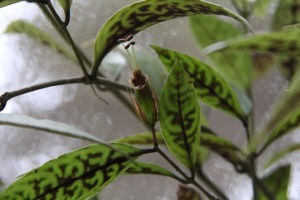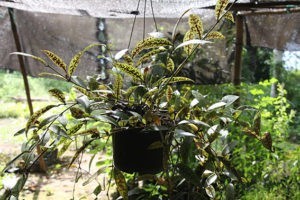Scientific name: Aeschynanthus longicaulis
English common name: Zebra Basket Vine
Lao name: Pang lay
Plant family: Gesneriaceae
To find this plant, one has to venture into the humid jungle, as it is an epiphyte that grows on large trees, on fallen tree trunks, or, rarely, on rocks. Like the plants in the genus Hoya, with which it is often confused, this creeper likes moisture and relatively low light.

The lovely little flower and patterned leaves.
Firstly, one will notice its simple, dark green, spear-shaped leaves, which are relatively fleshy and smooth, a little like those of succulent plants; their upper side is marbled in hues of green, with a red, somewhat striped pattern on the underside (presumably this is where the “zebra” part of its name comes in). The flowers, either at the tip of a branch or the base of a leaf, bloom singly or in pairs: a cup of five petals, a tubular corolla, green outside and dark red and yellow inside, from which emerge four long stamens and an even longer style. Its fruit is a long, narrow capsule containing seeds with long, silky hairs.
Aeschynanthus is a kind of tropical plant that has been known for centuries, particularly in Southeast Asia. The species Aeschynanthus longicaulis was first described in 1829, in Thailand, by the botanist Nathaniel Wallich. Since then, horticulturists have grown large numbers of these plants, as, like orchids, they look beautiful in hanging baskets.

Beyond its visual appeal, this plant is used as medication by local healers in the north of Laos, where it is found in the forests. When placed whole in boiling water it provides excellent relief from stomach ache.
Text by Biba Vilaylek, PTK Ethnobotanist. Translation kindly done by Gillian Marshall. Edits and photographs by Bryony Smart, PTK Botanist.



